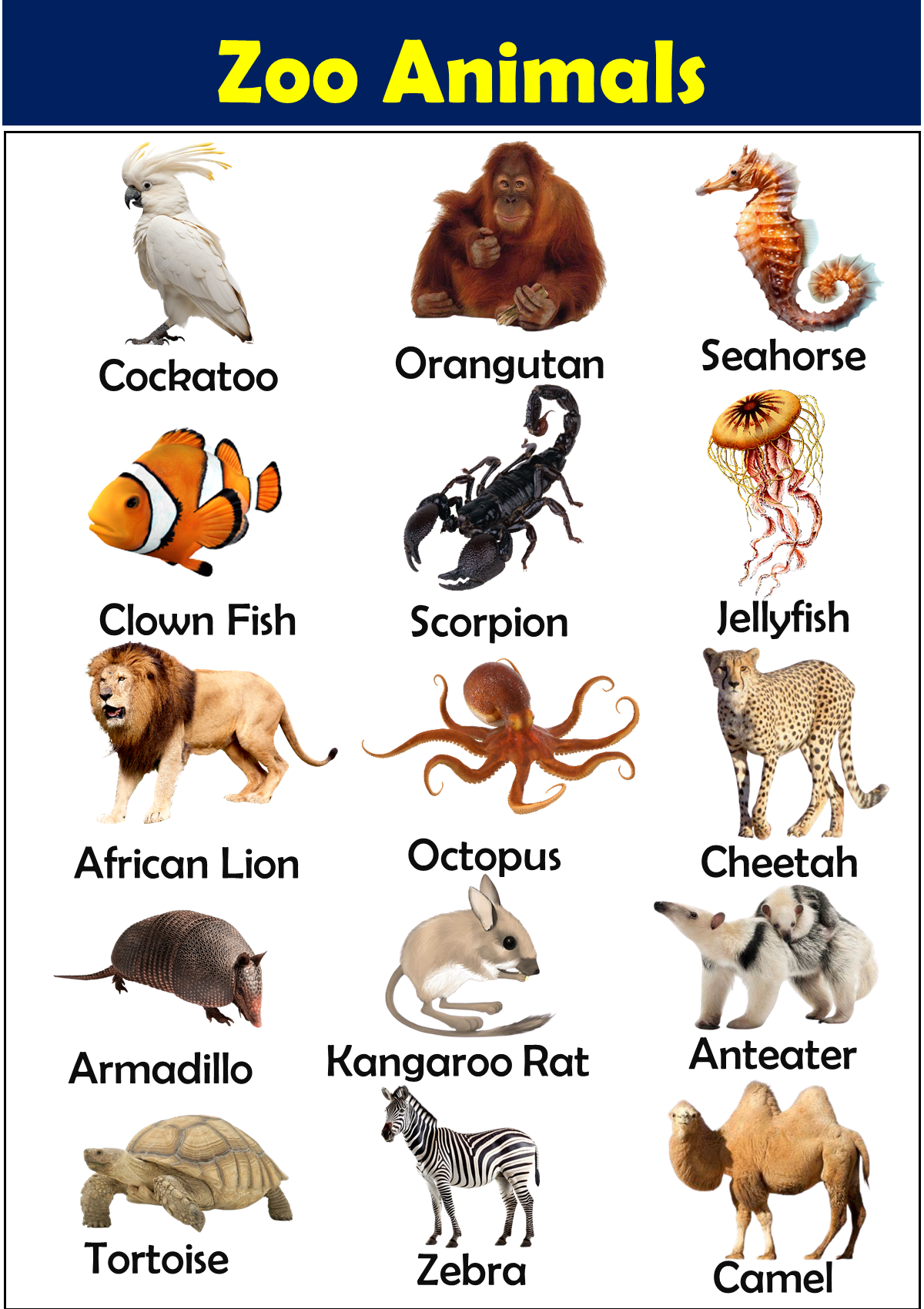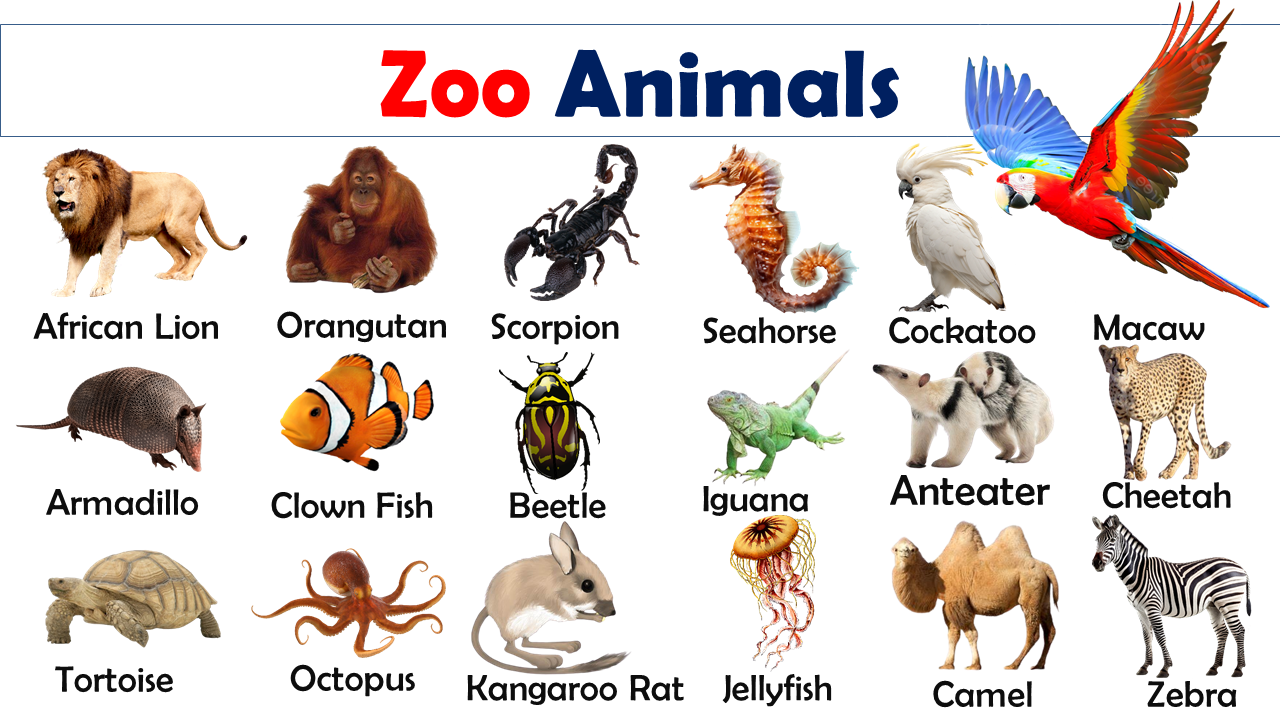Zoos are magical places where you can see a wide variety of animals from all around the world, all in one place. In this blog post, we’ll learn about different zoo animals, from the towering giraffe to the playful otter. Each animal at the zoo has unique features and interesting behaviors. We’ll explore where these animals come from, what they like to eat, and some fun facts about them. This is a great chance to grow your English vocabulary by learning about the amazing animals that live in zoos!
What are Zoo Animals?
Zoo animals encompass a wide variety of species that are kept in zoological parks for education, conservation, and public enjoyment. Zoos aim to provide a safe environment for animals that might be endangered or have lost their natural habitats. They also serve as centers for biological research and breeding programs for rare species. Here’s a list of 70 animals that are commonly found in zoos around the world.
List of Zoo Animals
- African Lion
- Asian Elephant
- Sumatran Tiger
- Gorilla
- Chimpanzee
- Red Panda
- Koala
- Grizzly Bear
- Polar Bear
- Bald Eagle
- Flamingo
- Emperor Penguin
- Snow Leopard
- Giraffe
- Zebra
- Rhinoceros
- Hippopotamus
- Orangutan
- Cheetah
- Sloth
- Komodo Dragon
- Giant Panda
- Meerkat
- Kangaroo
- Tasmanian Devil
- Lynx
- Arctic Fox
- Sea Otter
- Walrus
- Seal
- Manatee
- American Bison
- African Wild Dog
- Hyena
- Lemur
- Capybara
- Anteater
- Armadillo
- Elephant Seal
- Mongoose
- Warthog
- Camel
- Ostrich
- Alligator
- Crocodile
- Python
- Rattlesnake
- Iguana
- Chameleon
- Tortoise
- Falcon
- Owl
- Macaw
- Parrot
- Cockatoo
- Tiger Salamander
- Axolotl
- Clown Fish
- Seahorse
- Jellyfish
- Octopus
- Tarantula
- Scorpion
- Beetle
- Kangaroo Rat
- Squirrel Monkey
- Fruit Bat
- Gazelle
- Dik-dik
- Impala
Explore More Animal Vocab:
Tropical Rainforest Animals | Safari Animals | Tundra Animals

Zoo Animals Vocabulary and Their Facts
1. African Lion
The African lion, a symbol of strength and courage, is known for its majestic mane and powerful roar. Lions live in groups called prides, consisting mostly of related females and their offspring, led by a coalition of males. They are apex predators in their native African savannas, playing a key role in controlling populations of large herbivores and maintaining ecosystem balance.
2. Asian Elephant
Asian elephants are slightly smaller than their African counterparts, with smaller ears and a more rounded back. They are highly intelligent and social animals, known for their complex behaviors and strong familial bonds. Elephants are keystone species, significantly impacting their environments by facilitating forest regeneration through seed dispersal.
3. Sumatran Tiger
The Sumatran tiger is the smallest of the tiger subspecies and is critically endangered due to habitat loss and poaching. These solitary hunters are remarkably adaptive, able to swim and climb trees to track prey. Conservation efforts in zoos are vital for their survival, focusing on breeding programs and raising awareness about their plight.
4. Gorilla
Gorillas are the largest primates, known for their muscular build and predominantly herbivorous diet. They live in family groups led by a dominant male known as a silverback. Zoos contribute to gorilla conservation by participating in breeding programs and educating the public about threats like habitat destruction and poaching.
5. Chimpanzee
Chimpanzees are our closest living relatives, sharing about 98% of our DNA. They are highly social and intelligent, capable of using tools and exhibiting complex emotional behaviors. Conservation education in zoos highlights the threats chimpanzees face, such as habitat loss and the illegal wildlife trade.
6. Red Panda
Red pandas are small tree-dwelling animals from the eastern Himalayas and southwestern China. Unlike giant pandas, they have a diet primarily of bamboo, but they also eat eggs, birds, and insects. They are known for their striking red fur and bushy tails, which provide insulation and balance.
7. Koala
Koalas are iconic Australian marsupials, not bears as commonly misidentified. They spend most of their life in eucalyptus trees, feeding almost exclusively on the leaves, which are toxic to most other animals. Koalas are a flagship species for conservation efforts due to their vulnerability to habitat destruction and climate change.
8. Grizzly Bear
Grizzly bears, a subspecies of the brown bear, have a prominent muscular hump on their shoulders and long claws for digging. They are omnivores, eating a mixed diet of plants, insects, and small mammals. Grizzly bears play a crucial role in their ecosystems as top predators and seed dispersers.
9. Polar Bear
Polar bears are the largest land carnivores, native to the Arctic region. Their white coats provide camouflage in their snowy environment, and their body fat insulates against the cold. Polar bears are marine mammals, spending significant time hunting seals on sea ice, which is diminishing due to climate change.
10. Bald Eagle
The bald eagle, the national bird of the United States, is a powerful raptor known for its white head and tail contrasting with a dark brown body. They feed primarily on fish, which they catch with their sharp talons. Conservation efforts have successfully brought them back from the brink of extinction.
11. Flamingo
Flamingos are famous for their bright pink feathers, which result from carotenoid pigments in their diet of algae and crustaceans. They have specialized beaks designed to filter food from water. Flamingos are social birds, often seen in large flocks, which helps in predator deterrence and increases feeding efficiency.
12. Emperor Penguin
The emperor penguin is the tallest and heaviest of all penguin species, known for the incredible journey males endure to incubate eggs through the Antarctic winter. They rely heavily on their dense, waterproof feathers for insulation against cold temperatures. Zoos help study their behaviors and physiology, contributing to broader conservation knowledge.
13. Snow Leopard
Snow leopards are elusive big cats native to the mountain ranges of Central and South Asia. Adapted to cold, mountainous environments, they have thick fur and a long tail for warmth and balance. Poaching and habitat loss threaten their survival, making zoo conservation programs critically important.
14. Giraffe
Giraffes are the tallest mammals on earth, with their long necks allowing them to access leaves high in trees. Their height also provides advantages in predator detection. Giraffes have a distinct pattern of coat spots that are unique to each individual, similar to human fingerprints.
15. Zebra
Zebras are best known for their distinctive black and white stripes, which are believed to serve as camouflage to confuse predators and as a mechanism to deter biting flies. They are social animals that migrate in large herds and graze on a variety of grasses.
16. Rhinoceros
Rhinoceroses, or rhinos, are known for their armored appearance and large horns, made of keratin. There are several species, but all share a robust, bulky body and a reputation for being both strong and fast when necessary. Rhinos are important for ecological balance, their grazing habits helping to shape the landscapes of African and Asian grasslands.
17. Hippopotamus
Hippos are semi-aquatic mammals, spending much of their time in rivers and lakes to keep their massive bodies cool under the African sun. They are known to be highly territorial in water. Hippos have large mouths and strong teeth, primarily eating short grass. Their paths from water to grazing grounds help maintain the natural channels in their habitats.
18. Orangutan
Orangutans are great apes known for their reddish-brown hair and distinctive long arms. Native to Indonesia and Malaysia, they spend most of their life in trees and are critically endangered due to deforestation and land conversion. Conservation efforts in zoos focus on breeding programs and educating the public about sustainable palm oil consumption to protect orangutan habitats.
19. Cheetah
Cheetahs are renowned for their speed, able to accelerate from zero to sixty miles per hour in just a few seconds. This adaptation helps them catch fleet-footed prey like gazelles. Cheetahs have a slender body and a long tail that helps with balance during high-speed chases. Zoos play a crucial role in their conservation through breeding programs and genetic research.
20. Sloth
Sloths are known for their slow movement and spending most of their life hanging upside down in trees. They have a unique metabolism adapted to their low-energy diet of leaves and are found in the rainforests of Central and South America. Zoos help in studying their unique biology and educating the public on the ecological role of rainforest species.
21. Komodo Dragon
The Komodo dragon is the largest living species of lizard, found on a few Indonesian islands. These reptiles are dominant predators in their ecosystems, feeding on anything from birds to deer. Interesting fact: they have venom glands that play a role in subduing prey. Zoos contribute to their conservation by providing veterinary care and helping maintain genetic diversity.
22. Giant Panda
Giant pandas are iconic symbols of wildlife conservation, known for their distinctive black and white coloring and their diet primarily consisting of bamboo. Native to China, these bears play a crucial role in their environments by spreading seeds and facilitating growth of vegetation. Zoos around the world participate in breeding programs that have helped increase their populations.
23. Meerkat
Meerkats are small mammals from the mongoose family, known for their upright posture. They live in large groups in burrows and have a complex social structure. Their diet includes insects, spiders, and small vertebrates. Educational programs in zoos highlight their adaptive behaviors and roles in their native desert environments.
24. Kangaroo
Kangaroos are marsupials from Australia, recognized by their powerful hind legs and large tails, which help with balance while hopping. They are primarily grazers, and their diet helps maintain grassland health. Zoos provide insights into their unique reproductive biology, where the joey develops in the mother’s pouch.
25. Tasmanian Devil
The Tasmanian devil is a carnivorous marsupial known for its robust build and ferocious feeding habits. It is native to Tasmania and plays a vital role in controlling the populations of other animals and removing carrion from the environment. Zoos support conservation efforts by managing disease within populations and breeding genetically diverse individuals.
26. Lynx
Lynxes are medium-sized wild cats, identifiable by their tufted ears and short tails. They are adapted to life in cold environments with thick fur and wide paws that act like snowshoes. Zoos help in preserving these often solitary animals, which are crucial for controlling prey populations in their native habitats.
27. Arctic Fox
Arctic foxes have adaptations such as thick fur and a keen sense of hearing, which allow them to survive in extreme cold environments. Their coat changes color with the seasons for camouflage. Zoos help study their behaviors and adaptability to climate change, as well as educate the public about the impacts of global warming on Arctic species.
28. Sea Otter
Sea otters are marine mammals with an important role in maintaining kelp forest ecosystems. They use rocks to break open shellfish, which is a key part of their diet. By controlling sea urchin populations, they help preserve kelp forests, which are crucial marine habitats. Zoos and aquariums contribute to research on their ecology and conservation.
29. Walrus
Walruses are large marine mammals with distinctive long tusks, which they use for mating displays and to haul themselves onto ice. They are benthic feeders, consuming a variety of invertebrates. Educational programs in zoos focus on their adaptations to polar life and the challenges they face due to diminishing ice cover due to climate change.
30. Seal
Seals are adapted to aquatic life with streamlined bodies and limbs modified into flippers. They can be found in a variety of habitats, from polar seas to tropical waters. Zoos and aquariums educate the public about their diverse lifestyles and the conservation issues they face, such as habitat loss and pollution impacts.
